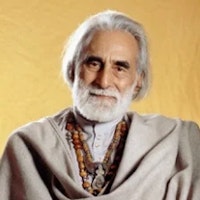Getting in the consciousness of highly attuned beings will trigger off a kind of resonance in us—just as two harps tuned to the same pitch will strike the same chord.
Getting in the consciousness of highly attuned beings will trigger off a kind of resonance in us—just as two harps tuned to the same pitch will strike the same chord.
Pir Vilayat Inayat Khan

In the Consciousness
Topic: Prayer, Meditation, & Contemplation
Especially today, it is often the case that trustworthy and experienced spiritual guides are difficult to find. Yet the Sufis have a longstanding practice that provides an antidote to this modern dilemma: turning to humankind’s great masters, saints, or prophets such as Moses, Krishna, Jesus, Kuan Yin, Zoroaster, Melchizedek, Muhammad, and others. They form a hierarchy of mystical transmission reaching into the very highest levels of realization announcing the spiritual dimension of our day and age and indeed future spirituality… Just like tuning the strings of a violin to a note struck on the piano, concentrating on an “ideal being” has the effect of harmonizing that within us which has fallen out of tune with the Divine perspective. While our own spiritual dimension may be latent within us, that of certain great souls is vibrantly awakened. Getting in the consciousness of highly attuned beings will trigger off a kind of resonance in us—just as two harps tuned to the same pitch will strike the same chord.
Pir Vilayat Inayat Khan, born in 1916 in London, was the son of Hazrat Inayat Khan, a notable Sufi mystic who established the Sufi Order International. Raised in France, Pir Vilayat was immersed in both Eastern and Western cultures from a young age. He pursued his education at the prestigious Sorbonne University in Paris, studying psychology and philosophy, and furthered his studies at Oxford University. His artistic inclination led him to study musical composition and cello at the Ecole Normale de Musique in Paris, showcasing his diverse interests and talents.
After serving in the British Royal Navy during World War II, Pir Vilayat embarked on a spiritual quest, traveling extensively in India and the Middle East. His journey enriched his understanding of various religious traditions, culminating in his initiation into the Chishti Sufi Order of India. As a Pir, or spiritual teacher, he returned to the West in the 1950s, where he began disseminating a universal approach to spirituality. His teachings were grounded in meditation and inner exploration, drawing from the wisdom of various religious traditions to create an inclusive, globally relevant spiritual path.
Pir Vilayat’s contributions extended beyond spiritual teaching. A prolific author, he penned over 30 books on Sufism and spirituality, including notable works like "The Essence of Sufism" and "The Way of Illumination." His eloquence as a speaker and lecturer took him around the world, advocating for interfaith dialogue and the integration of diverse religious insights. His work in transpersonal psychology revealed his belief in the potential of psychology to aid in spiritual growth. Pir Vilayat's passing in 2004 marked the end of an era, but his legacy as a bridge between Eastern and Western spiritual traditions continues to inspire. His teachings offer timeless wisdom, guiding people towards inner peace and spiritual transformation, irrespective of their cultural or religious backgrounds.
Ours Is a Way of Light
Khan, Pir Vilayat Inayat. Awakening: a Sufi Experience. J.P. Tarcher/Putnam, 2000. [Pir Vilayat Inayat Khan, Ours is a Way of Light].

Pir Vilayat Inayat Khan
Theme: Meditation and Contemplation

About This Pir Vilayat Inayat Khan Quotation [Commentary]
Pir Vilayat Inayat Khan teaches that “getting in the consciousness of highly attuned beings will trigger off a kind of resonance in us—just as two harps tuned to the same pitch will strike the same chord.” In the Sufi tradition, this inner resonance is not metaphorical but real. He writes of a “hierarchy of mystical transmission” formed by great masters, saints, and prophets such as Moses, Krishna, Jesus, Kuan Yin, Zoroaster, Melchizedek, and Muhammad. These beings represent “the very highest levels of realization,” and through contemplative concentration on them, it becomes possible to “harmoniz[e] that within us which has fallen out of tune with the Divine perspective.”
This is especially relevant, he notes, in a time when “trustworthy and experienced spiritual guides are difficult to find.” The Sufi practice of turning toward an “ideal being” becomes a spiritual method that awakens what is “latent within us.” Pir Vilayat Inayat Khan compares this to “tuning the strings of a violin to a note struck on the piano.” The image points to a contemplative alignment rather than passive admiration—an attunement that brings the soul back into relationship with a greater order. While the spiritual presence of awakened beings is fully alive, it is through inward concentration that their clarity can begin to resonate within us.
Meditation and contemplation serve as a way to enter this resonance. As Pir Vilayat Inayat Khan explains, “that of certain great souls is vibrantly awakened,” and through conscious connection with them, “a kind of resonance” begins to move in us. The process is not about adopting beliefs or following outer forms but about coming into alignment with what is already present and awakened in another. This gentle but real resonance helps restore a sense of spiritual balance, allowing the seeker to participate in a deeper harmony that reflects the Divine.
Additional Pir Vilayat Inayat Khan Quotes
Resources
Related Quotes
Copyright © 2017 – 2025 LuminaryQuotes.com About Us